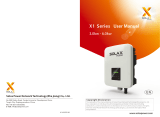
3
-
Any time the inverter has been disconnected from the public network, please be extremely cautious
as some components can retain charge sufficient to create a shock hazard. Prior to touching any
part of the inverter please ensure surfaces and equipment are under touch safe temperatures and
voltage potentials before proceeding.
2.2 PE Connection and Leakage Current
PV System Residual Current Factors
-
In every PV installation, several elements contribute to the current leakage to protective earth (PE).
these elements can be divided into two main types.
-
Capacitive discharge current - Discharge current is generated mainly by the parasitic capacitance of
the PV modules to PE. The module type, the environmental conditions (rain, humidity) and even the
distance of the modules from the roof can effect the discharge current. Other factors that may
contribute to the parasitic capacitance are the inverter’s internal capacitance to PE and external
protection elements such as lighting protection.
-
During operation, the DC bus is connected to the alternating current grid via the inverter. Thus, a
portion of the alternating voltage amplitude arrives at the DC bus. The fluctuating voltage constantly
changes the charge state of the parasitic PV capacitor (i.e capacitance to PE). This is associated
with a displacement current, which is proportional to the capacitance and the applied voltage
amplitude.
-
Residual current - if there is a fault, such as defective insulation, where an energized cable comes
into contact with a grounded person, an additional current flows, known as a residual current.
Residual Current Device (RCD)
-
All FOXESS inverters incorporate a certified internal RCD (Residual Current Device) to protect
against possible electrocution in case of a malfunction of the PV array, cables or inverter (DC). The
RCD in the FOXESS inverter can detect leakage on the DC side. There are 2 trip thresholds for the
RCD as required by the DIN VDE 0126-1-1 standard. A low threshold is used to protect against
rapid changes in leakage typical of direct contact by people. A higher threshold is used for slowly
rising leakage currents, to limit the current in grounding conductors for the safety. The default value
for higher speed personal protection is 30mA, and 300mA per unit for lower speed fire safety.
Installation and Selection of an External RCD device
-
An external RCD is required in some countries. The installer must check which type of RCD is
required by the specific local electric codes. Installation of an RCD must always be conducted in
accordance with local codes and standards. FOXESS recommends the use of a type-A RCD.
Unless a lower value is required by the specific local electric codes, FOXESS suggests an RCD
value between 100mA and 300mA.
-
In installations where the local electric code requires an RCD with a lower leakage setting, the
discharge current might result in nuisance tripping of the external RCD. The following steps are
recommended to avoid nuisance tripping of the external RCD:
1. Selecting the appropriate RCD is important for correct operation of the installation. An RCD with a
rating of 30mA may actually trip at a leakage as 15mA (according to IEC 61008). High quality RCDs will
typically trip at a value closer to their rating.
2. Configure the trip current of the inverter’ internal RCD to a lower value than the trip current of the
external RCD. The internal RCD will trip if the current is higher than the allowed current, but because the
internal inverter RCD automatically resets when the residual currents are low it saves the manual reset.





















